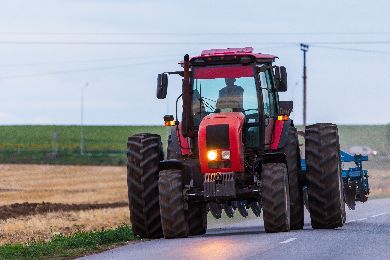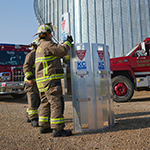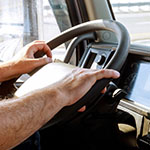Ag equipment safety on rural roads

Nationwide Agribusiness reminds farmers to safely navigate large agricultural equipment over rural roads to and from the fields, especially during the busy spring planting season. Service drivers hit the roads before dawn and come back long after the sun has set, and darkness has blanketed the roads.
Accidents are more prevalent at certain times of the day. Operating in the morning presents an increased risk as people head off to work and school. Drivers are usually in a hurry and often lack the patience to follow a slow-moving vehicle. The same is true during afternoons and early evenings as schools let out and people are returning home from work.
Safety First. Is your vehicle ready to hit the road?
All drivers must understand the hazards of driving and the importance of sharing the road with others before getting behind the wheel. Never use inexperienced or untrained drivers. Regulations require drivers to be trained on how to operate the specific equipment they are assigned to use and to how to navigate the equipment in the environment in which they are operating.
Consider these safety tips before you start your farm vehicle:
- Light it up. Keep your equipment visible and safe with CLEAN proper lighting.
- Use reflectors or conspicuity tape.
- Display a slow-moving vehicle (SMV) sign.
- Use an escort vehicle, which should use four-way flashers if you do not have the proper lighting on the rear of the equipment.
Left-turn collisions
The left-turn collision is one of the most common accidents involving articulating farm vehicles, such as a tractor pulling a tool bar and nurse tank. When attempting to make a left turn, equipment operators commonly pull to the right in order to make a wide left turn. This movement may be misinterpreted by motorists behind the equipment as permission to pass.
To prevent accidents, equipment operators should consider the following safety measures:
- Use equipped turn signals or hand/arm signals when operating older equipment.
- Before committing to the turn, pay close attention to oncoming traffic and check all mirrors or look over your shoulder to ensure motorists are not trying to pass.
Rural bridges and large farm equipment
Large farm equipment and old bridges do not mix. Before crossing a rural bridge, make sure your vehicle weight will not damage the bridge or cause it to collapse.
Rural bridges are often very narrow. Allow oncoming traffic to clear the bridge before starting across. This reduces the total weight on the bridge and gives you more space to maneuver.
Tractors, Combines, and Sprayers have high wheels with tires that have large lugs to facilitate traction. If you pull right to cross the bridge with oncoming traffic, your tires can easily meet the guardrail and subsequently cause your equipment to climb the rail or even tip off the bridge.
Pass with care
When driving a slow-moving vehicle, there will always be other motorists wanting to pass. You should never wave a driver to pass. It is their responsibility to pass - not yours.
Do not drive with one-half of your vehicle on the shoulder either. As the passing vehicle straddles the center line, your equipment may sideswipe it if you have to swerve to avoid an oncoming mailbox, road sign or other obstruction.
Always drive with the left side of your vehicle to the centerline, even though the width of your equipment tends onto the shoulder. If a vehicle needs to pass, the driver will have to make that decision based on the law and safe opportunity to do so.
Rear-end collisions
On contoured rural roads, it is easy for a car traveling at a higher speed to be surprised by a larger, slow-moving vehicle, especially around a sharp bend or after the crest of a hill. It is difficult for drivers of faster, smaller vehicles to judge the speed and gap distance of a larger piece of equipment.
You can help avoid rear-end collisions by monitoring your mirrors for fast-approaching vehicles and making sure your vehicle's warning devices, such as SMV signs, are clearly visible When moving large ag equipment on heavily traveled paved roads, you should utilize an escort vehicle.
References
Upper Midwest Agricultural Safety and Health Center, Farm Safety Check: Roadway Safety, https://umash.umn.edu/farm-safety-check-roadway-safety/
Governors Highway Safety Association, https://www.ghsa.org/resources/GHSA/Rural-Road-Safety22

 >
>

 >
>
 >
>